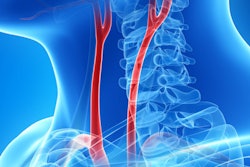
The use of CT angiography (CTA) as the first-line imaging exam for carotid artery stenosis has increased nearly threefold during the past several years, raising concerns over growing patient costs and radiation exposure, according to a study presented at RSNA 2019.
The researchers, led by Dr. Jina Pakpoor from Johns Hopkins Hospital, examined imaging requests for the diagnosis of carotid artery stenosis from outpatient centers across the U.S. Their analysis of the data revealed that CTA usage rates increased every year from 2011 to 2016, whereas ultrasound usage steadily trended downward.
"Overall, there is actually high compliance with the current recommendation to use Doppler ultrasound for initial testing," Pakpoor told session attendees. "We did, however, find that there was a shift in the direction, where CTA use is increasing and Doppler ultrasound use is actually decreasing, which is going to have higher costs for patients and higher radiation exposure."
CTA on the rise
Current guidelines from the Society of Vascular Surgery recommend Doppler ultrasound as the first-line imaging exam for carotid stenosis. More advanced imaging exams such as CTA and MR angiography (MRA) are typically reserved as a second-line imaging test for cases requiring more detailed stenosis characterization or urgent therapy.
 Dr. Jina Pakpoor.
Dr. Jina Pakpoor.However, recent studies have shown that CT usage rates have increased dramatically for carotid imaging in general over the past decade, whereas rates for other imaging modalities have been decreasing. These reports motivated Pakpoor and colleagues to determine whether physicians in the U.S. were complying with existing guidelines for the initial imaging workup of suspected carotid artery stenosis in the outpatient setting.
The researchers obtained information from the 2011 to 2016 IBM MarketScan U.S. national commercial claims and insurance database, which includes data submitted by large employers, managed care organizations, hospitals, electronic medical record providers, Medicare, and Medicaid.
The study population included 229,464 patients ages 18 to 65 who underwent neck CT angiography, Doppler ultrasound, or MR angiography for their first carotid stenosis encounter. Approximately half of the patients were male, and their average age was 55.
Over the eight-year period, the vast majority of patients received an ultrasound exam at 95.8%, followed by CTA at 2.4%, and finally MRA at 1.3%.
Though ultrasound remained by far the most used imaging modality overall, a year-by-year analysis showed that the ultrasound usage rate decreased by a statistically significant degree from 2011 to 2016. In contrast, the usage rates roughly tripled for CTA and remained relatively constant for MRA.
| Trends in carotid stenosis detection on ultrasound, MRA, and CTA | ||||||
| 2011 | 2016 | |||||
| Ultrasound | MRA | CTA | Ultrasound | MRA | CTA | |
| Proportion of all imaging exams | 96.9% | 1.2% | 1.6% | 93.8% | 1.5% | 4.7% |
Room for concern
Further analysis revealed that use of CTA and MRA varied depending on the region of the U.S. where the exams were performed. To be specific, combined CTA and MRA use was considerably greater in the western U.S. (5.5%) than in the northeastern U.S. (2%; p < 0.001). In addition, females were more likely than males to receive advanced imaging.
Though most referring providers appear to be complying with current recommendations for the diagnosis of carotid stenosis, the sustained increase in CTA utilization poses a concern, Pakpoor noted. Growing reliance on CTA for first-line imaging may stem from the increasing availability of CT scanners throughout the U.S.
"These days a lot of institutions have CT scanners available in the emergency department, and CT is known as a modality that you can easily and quickly get access to," she said. "And from a provider's perspective, if you're not worried about practice costs and radiation, CTA can provide a lot more information and avoid the need for a second [imaging] study. But it is not the current recommendation, and we don't want people to be moving in that direction."
The findings suggest a possible need to educate outpatient providers on the appropriate protocol in order to prevent this trend from continuing in the same direction, Pakpoor concluded. "It will certainly be something important to look at in the future -- to emphasize the importance of continuing to use Doppler ultrasound as the first modality, despite the fact that we're seeing an increase in use of CT over all aspects of radiology."




















